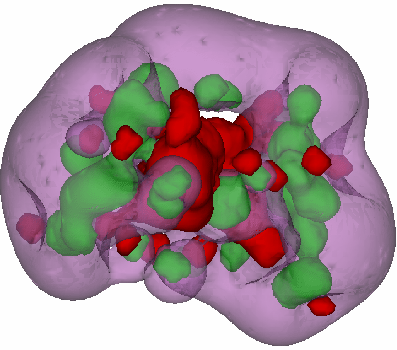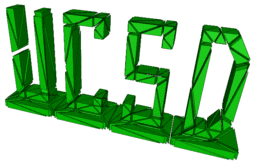| Michael Holst | ||
| https://ccom.ucsd.edu/~mholst/ |
Distinguished Professor of Mathematics and Physics UC San Diego |
|
|
The Nonlinear Poisson-Boltzmann Equation
Potential isosurfaces of an SOD enzyme. 
The red and green isosurfaces represent electrostatic potentials of +3.0 and -3.0 [k T]/e energy units respectively. The translucent purple isosurface represents an electrostatic potential of -0.7 [k T]/e energy units. The potential field was obtained by solving the nonlinear Poisson-Boltzmann equation numerically, using the damped-inexact-Newton-multilevel method. The enzyme has two binding sites, which can be seen when viewing certain isosurface orientations. The SOD (SuperOxide Dismutase) enzyme is an antiradical or antioxident, meaning that it moves around the body binding to and then deactivating free radicals in the body, preventing them from causing cancer or other cell damage in the body. The physical structure of the SOD enzyme itself may be seen here. An MPEG movie of the rotating isosurfaces can be viewed here. It is believed that antiradicals such as SOD can help prevent cancer, heart disease, and a host of other diseases, and perhaps even delay the aging process. The electrostatic steering effect of the SOD enzyme, which enables it to attract, bind to, and deactivate free radicals in the human body, is vividly seen in the above graph. The negatively charged surface surrounding the postively charged binding sites has the effect of ``steering'' the radical into the site, from the upper left of the graph into the ``hole'' in the electrostatic surface. The linearized and nonlinear Poisson-Boltzmann models yield substantially different electrostatic potential values near the binding sites, leading to correspondingly different reaction rates predicted by Brownian dynamics simulations. This implies that the full nonlinear model is important for certain modeling situations. In the March 4, 1993 issue of the New York times, it was announced that researchers at MIT had discovered that the gene responsible for generating the antiradical SOD in the human body is defective in patients with amytrophic lateral sclerosis (ALS), also known as Lou Gehrig's disease. The discovery was deemed so important that the MIT report was accepted for publication by the journal Nature within 36 hours of submission. Using models such as the nonlinear Poisson-Boltmann model to gain a better understanding of the function of antiradical enzymes such as SOD, it is hoped that new drug therapies will be developed for diseases such as ALS based on synthetic antiradical agents. Related Work: Michael Holst's HomePage Image of the SOD electrostatic potentials were produced by James Patton using AVS on an IBM RS6000. |
